Should We Think of Our Setting as a Character?
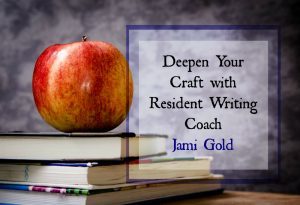
We���ve probably all heard some variation of the advice to develop story settings that feel like characters. Hogwarts castle in the Harry Potter story world, the Overlook Hotel in The Shining, and East and West Egg in The Great Gatsby are all frequently listed as examples of settings that come alive in readers��� imaginations.
However, we also know that not all advice applies to every writer or story. So let���s dig into this idea: Should we apply the advice ���think of your setting as a character��� to our story���and if so, how?
The Building Blocks of Our StoryNewer writers often conflate the terms story and plot, but plot is just one piece of our story. In general, the biggest story elements are:
CharacterPlotSetting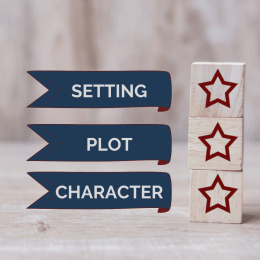
We could usually change the voice or mood or point-of-view (or other various elements) and still have the same basic story. But if we change the bigger elements, the chances are higher that the story itself would change on a fundamental level.
Not always, of course.
Stories focused on character arcs can often swap out plot points and end up with the same story-level insights into how the characters learn and grow in the face of whatever challenges we choose for the plot. Conversely, we���ve likely all come across plot-focused stories where character inconsistency is the norm because they���re just puppets doing what the plot needs them to do.
Similarly, settings can be hugely important to some stories and mere background to others. One option isn���t ���right,��� and the other option isn���t ���wrong������there are simply different types of stories. We need to figure out what type of story we have (or want to have) and make sure our setting supports that goal.
What Type of Story Do We Have?How much does the setting of our story matter? We can ask ourselves:
Does our story have a recurring setting?Could our story take place almost anywhere?What would change (if anything) if our setting were different?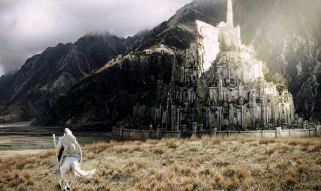
For example, some stories don���t revisit settings, so the setting is important only if the overall story world is worth a deeper study. (Think of the development of Tolkien���s Middle-earth world even though the Lord of the Rings story follows the characters on a ���road trip��� without recurring settings.) Or for another example, the setting for a story in a generic office might be important only for readers to know that the story takes place in a real-world-style contemporary office.
It’s the need (or desire) for a specific type of setting that matters ��� whether that means a specific type of story world, a specific atmosphere in a house, a specific culture of a workplace, etc. Going back to our generic office example, a fuller setting development might be helpful if we wanted to use specific setting details to add layers to our story, such as reflecting the emotions of our characters or story mood, creating a metaphor for our character���s experience, etc.
If that���s not the case, there���s nothing wrong with ignoring the ���treat settings like characters��� advice. We���re simply not writing that type of story, and we don���t need to overthink the details of our setting.
How Do We Treat Our Setting as a Character?While many of us enjoy reading stories where settings come to life, we often struggle to write such settings ourselves. (Of course, with their Urban and Rural Setting Thesaurus books, blog posts, and Setting Planner Tool, Angela and Becca have plenty of tips for writing settings!)
If we think of our setting as a character, we can add development along the lines of:
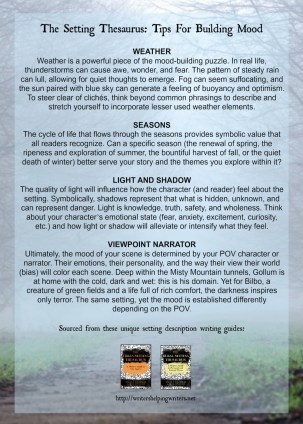 Personality and Backstory: Our characters��� backstory gives them a certain personality that we keep consistent throughout our story (unless they have reasons to act out of character). Similarly, the history or culture of a place can develop the ���rules��� and personality of our setting, and when we follow those rules consistently, we create a world that feels realistic (no matter how fantastical it is).Emotional Aspects: When writing characters, we include details beyond physical description that help readers recognize who the character is on the inside. We can include deeper descriptions with our settings too:
Personality and Backstory: Our characters��� backstory gives them a certain personality that we keep consistent throughout our story (unless they have reasons to act out of character). Similarly, the history or culture of a place can develop the ���rules��� and personality of our setting, and when we follow those rules consistently, we create a world that feels realistic (no matter how fantastical it is).Emotional Aspects: When writing characters, we include details beyond physical description that help readers recognize who the character is on the inside. We can include deeper descriptions with our settings too:Does the setting evoke a certain mood or atmosphere (cold and unforgiving or vibrant and peaceful)? Does it symbolize something to characters (or to readers)? Does it reflect the emotions of the characters (a messy house for a messy mind, etc.)? Is it hiding secrets or built on lies? Are there iconic details that can make the setting recognizable as this specific place? How might readers emotionally connect to the setting?Conflicts: Just as characters come into conflict with each other, settings can trigger conflicts as well. (Angela and Becca���s Setting Checklist shares many conflict ideas.) From urban/rural to historical/modern, settings and environments affect everything from culture, rituals, and expectations to common obstacles and attitudes. How does our setting interact and influence our characters and our plot (and vice versa)?Arcs of Change: Our settings can change over the course of a story the same as our characters. They might change with the seasons, plot events might affect them physically (destruction from the villain, new trees planted, etc.), or our characters might simply perceive our setting differently as they���ve changed throughout the story.The Benefits of a Well-Developed Setting
We need only to think of our own experiences as readers to know what a well-written setting can do for our story. Countless readers wished for their own invitation letters to Hogwarts (never mind all the dangers experienced in every book!) so they could experience the wonder of Harry���s first visit for themselves.
Just as readers form emotional connections to characters, they can form emotional connections to settings. Sometimes those emotional connections to settings can be even stronger than to any specific character, such as with the Chronicles of Narnia series that swapped protagonists several times.
For another example of how much settings can matter, here in the U.S., generations of kids grew up with The Brady Bunch TV show, and the HGTV cable channel recently spent millions remodeling the original house used for the exterior of the Brady family���s home to have an interior to match the late-1960s/early-1970s studio sets. The HGTV show following the remodel project turned into their highest-rated series ever, and Brady Bunch fans helped crowd-source furniture and household items to stock the rooms and then competed for a chance to spend a week living in the ���old-fashioned��� house. That setting felt iconic and meaningful to viewers, and the same can happen with our stories.
When it fits our story, treating our setting as a character can give readers more reasons to emotionally connect to our story, and that���s always a good thing. *smile* Do you have any questions or insights about settings or when and how to fully develop them?
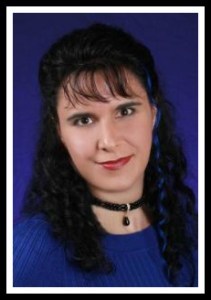 Jami GoldResident Writing Coach
Jami GoldResident Writing Coach After muttering writing advice in tongues, Jami decided to put her talent for making up stuff to good use. Fueled by chocolate, she creates writing resources and writes award-winning paranormal romance stories where normal need not apply. Just ask her family���and zombie cat. Find out more about Jami here, hang out with her on social media, or visit her website and Goodreads profile.
Twitter �� Facebook �� Pinterest
 Need Help Showing Your Character’s Hidden Emotion? Don’t Miss this Upcoming Webinar.
Need Help Showing Your Character’s Hidden Emotion? Don’t Miss this Upcoming Webinar.Join Angela on March 20th as she digs into a myriad of ways we can reveal what’s unspoken or hidden in dialogue exchanges and beyond, including our character’s true motivations and feelings. (If you struggle with showing fresh emotion, this is the webinar for you.)
More information & registration: Hidden Emotion & Subtext: Making Dialogue Crackle with What Isn’t Said
The post Should We Think of Our Setting as a Character? appeared first on WRITERS HELPING WRITERS��.
Writers Helping Writers
- Angela Ackerman's profile
- 1014 followers



